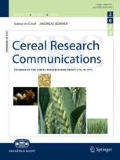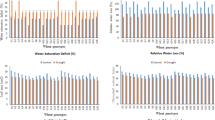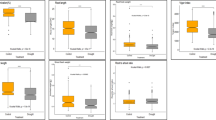Abstract
Drought is a serious global problem of agriculture. For this, an investigation was carried out with 25 wheat genotypes composed of cultivars and advanced lines to screen drought-tolerant bread wheat genotypes using multivariate analysis. The experiment was conducted in a split plot design with three replications and two treatments control and drought. The analysis of variance revealed significant differences among the genotypes and treatments for all the characters studied, viz. plant height, flag leaf collar height, flag leaf length, flag leaf breadth, chlorophyll a, chlorophyll b, proline content, number of tillers per plant, root fresh weight, shoot fresh weight and root–shoot ratio. High heritability was observed for all the traits except flag leaf length, flag leaf breadth and number of tillers per plant. Based on the genetic distances, all the 25 genotypes were grouped into three different clusters. In control conditions, cluster number I contained most tolerant genotypes and under drought conditions, cluster number III contained most drought-tolerant genotypes. In biplot, the genotypes SATYN-24, BARI Gom-24 and SATYN-2 contributed positively and correlated with number of tillers per plant, shoot fresh weight, flag leaf breadth, proline content and plant height under drought conditions. The drought susceptibility index (DSI) indicated that the genotypes BARI Gom-24 and SATYN-9 exhibited a highly drought-tolerant genotype in the present investigation. These genotypes might carry genes for drought tolerance and may be useful for further drought tolerance breeding.


Similar content being viewed by others
References
Ali MA, Zulkiffal M, Anwer J, Hussain M, Farooq J, Khan S (2015) Morpho-physiological diversity in advanced lines of bread wheat under drought conditions at post-anthesis stage. J Anim Plant Sci 25:431–441
Awan SI, Niaz S, Faisal M, Malik MFA, Ali S (2007) Analysis of variability and relationship among seedling traits and plant height in semi-dwarf wheat (Triticum aestivum L.). J Agric Soc Sci 3:59–62
CGIAR (2017) Research Program on Wheat. Retrieved from https://wheat.org/wheat-in-the-world/. Accessed on 15 July 2018
Devesh P, Moitra PK, Shukla RS, Pandey S (2019) Genetic diversity and principal component analyses for yield, yield components and quality traits of advanced lines of wheat. J Pharmacogn Phytochem 8:4834–4839
Farshadfar E, Jamshidi B, Aghaee M (2012) Biplot analysis of drought tolerance indicators in bread wheat lanraces of Iran. Int J Agric Crop Sci 4:226–233
Fischer RA, Maurer R (1978) Drought resistance in spring wheat cultivars. I. Grain yield response. Aust J Agric Res 29:897–912
Grzesiak S, Hordyńska N, Szczyrek P, Grzesiak MT, Noga A, Szechyńska-Hebda M (2019) Variation among wheat (Triticum easativum L.) genotypes in response to the drought stress: I—selection approaches. J Plant Interact 14:30–44
Jolliffe IT, Cadima J (2016) Principal component analysis: a review and recent developments. Philos Trans Math Phys Eng Sci 374:20150202
Khodadadi M, Fotokian HM, Miransari M (2011) Genetic diversity of wheat (Triticum aestivum L.) genotypes based on cluster and principal component analyses for breeding strategies. Aust J Crop Sci 5(1):17–24
Kutcher ME, Ferguson AR, Cohen MJ (2013) A principal component analysis of coagulation after trauma. J Trauma Acute Care Surg 74:1223
Lichtenthaler H, Wenzel O, Buschmann C, Gitelson A (1998) Plant stress detection by reflectance and fluorescence. In: Csermely P (ed) Stress of life: From molecules to man, vol 851. Ann. N. Y. Acad. Sci. New York Academy of Sciences, New York, pp 271–285
Ludlow MM, Muchow RC (1990) A critical evolution of traits for improving crop yields in water-limited environments. Adv Agron 43:107–153
Mahalanobis PC (1936) On the generalized distance in statistics. Proc Nat Inst Sci Ind 12:49–55
Mwadzingeni L, Shimelis H, Tislo T, Tesfay S (2016) Screening of bread wheat genotypes for drought tolerance using phenotypic and proline analyses. Front Plant Sci 7:1–12
Mwadzingeni L, Shimelis H, Tsilo TJ (2017) Variance components and heritability of yield and yield components of wheat under drought-stressed and non-stressed conditions. AJCS 11:1425–1430
Nouraein M, Mohammadi S, Aharizad S, Moghaddam VM, Sadeghzadeh B (2013) Evaluation of drought tolerance indices in wheat recombinant inbred line population. Ann Biol Res 4:113–122
Nowsherwan I, Shabbir G, Malik SI, Ilyas M, Iqbal MS, Musa M (2018) Effect of drought stress on different physiological traits in bread wheat. SAARC J Agric 16:1–6
R Core Team (2017) R: a language and environment for statistical computing. R Foundation for Statistical Computing, Vienna. https://www.R-project.org/
Raji AA (2002) Assessment of genetic diversity heterotic relationships in African improved and local cassava (Manihot esculenta C.) germplasm. PhD thesis. University of Ibadan, Nigeria
Samson G, Tremblay N, Dudelzak A, Babichenko S, Dextraze L, Wollring J (2000) Nutrient stress of corn plants: early detection and discrimination using a compact multiwavelength fluorescent Lidar. EARSeL e-Proceed, Dresden
Sangtarash MH (2010) Responses of different wheat genotypes to drought stress applied at different growth stages. Pak J Biol Sci 13:114–119
STAR version 2.0.1. (2014) Biometrics and Breeding Informatics, PBGB Division, International Rice Research Institute, Los Baños, Laguna, Philippines
Toscano S, Ferrante A, Romano D (2019) Response of mediterranean ornamental plants to drought stress. Horticulturae 5:6. https://doi.org/10.3390/horticulturae5010006
USDA (2018) Foreign agricultural service. Bangladesh, Grain and Feed Annual 2018. Retrieved from https://gain.fas.usda.gov/. Accessed on 31 Jan 2019
WHEAT (2014) Wheat: vital grain of civilization and food security 2013. Annual Report. CGIAR Research Program on Wheat, Mexico
Acknowledgements
We offer special thanks to Dr. M. A. Hakim, Senior Scientific Officer, Bangladesh Wheat and Maize Research Institute (BWMRI), Nashipur, Dinajpur, Bangladesh, for providing the germplasms. We are thankful to Mr. Tajul Islam for providing some support during the experimentation.
Author information
Authors and Affiliations
Corresponding author
Additional information
Communicated by M. Taylor.
Electronic supplementary material
Below is the link to the electronic supplementary material.
Rights and permissions
About this article
Cite this article
Arifuzzaman, M., Barman, S., Hayder, S. et al. Screening of bread wheat (Triticum aestivum L.) genotypes under drought stress conditions using multivariate analysis. CEREAL RESEARCH COMMUNICATIONS 48, 301–308 (2020). https://doi.org/10.1007/s42976-020-00039-8
Received:
Accepted:
Published:
Issue Date:
DOI: https://doi.org/10.1007/s42976-020-00039-8




